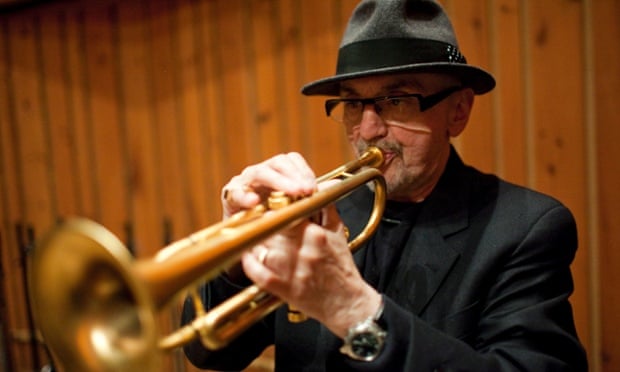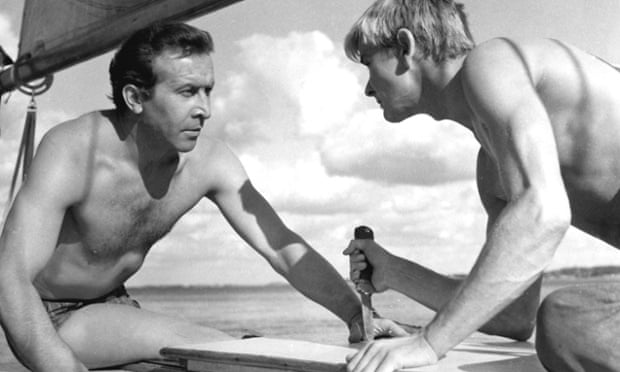Suppressed under Stalin and promoted on film, jazz has long been synonymous with freedom in Poland. Richard Williams surveys a thriving tradition that embraces the spirit of longing

‘No dictatorship can tolerate jazz,” the pianist and bandleader Dave Brubeck told a Polish audience in 1958, when he and his quartet became the first American jazz musicians to perform behind the Iron Curtain. “It is the first sign of a return to freedom.”
Brubeck played 12 concerts in seven cities during that tour, organised by the US State Department as part of a campaign to expose the citizens of communist countries to the cultural freedoms of the west. At the close of the last of the concerts, in Poznań, he performed a composition specially written for his Polish listeners. He titled it Dziekuje – Thank you – and introduced it with a solo piano section inspired by Chopin. When the piece finished, there was a moment of silence during which Brubeck suddenly feared that he might have insulted the memory of the nation’s greatest musical hero. Then the waves of applause crashed around him.
Among those flocking to hear Brubeck was a 16-year-old trumpeter about to begin his studies at the academy of music in Kraków. To the eager Tomasz Stańko, jazz represented “the opposite of communism. It was the synonym of freedom. It was the symbol of everything good.” His knowledge of the music had been developed by listening to Willis Conover’s Jazz Hour, broadcast nightly via the Voice of America radio network – another State Department initiative aimed at using jazz as a weapon in the cold war.
Over the years, Stańko would become a leading member of the generation of Polish musicians who established themselves, and their national scene, as a significant force in jazz. He and some of his compatriots – including the pianistsLeszek Możdżer and Marcin Masecki, the singer Alice Zawadski and the violinist and saxophonist Michał Urbaniak – are appearing this month at the London Jazz festival, which also features an evening devoted to the launch of Jazz in Polish Cinema, a box set of film soundtracks dating from the late 1950s to the mid 1960s.
Cinema was the medium through which several of Stańko’s contemporaries and collaborators gained their first international exposure. When the cineastes of the time heard Krzysztof Komeda’s soundtrack to Roman Polanski’s Knife in the Water in 1962, they were impressed by the way the cool modernity of the music’s timbres and cadences enhanced the young director’s sophisticated vision.
The generation of Stańko and Komeda benefited from the loosening of Poland’s cultural corset in the years that followed the death of Stalin in 1953. Under Władysław Gomułka and Edward Gierek, it became the Iron Curtain country most open to western influence, its artistic life flourishing until the imposition of martial law by General Wojciech Jaruzelski’s military government in 1981.

But jazz had been a familiar part of the country’s cultural landscape since long before the arrival of communism. The Karasinski and Kataszek Jazz-Tango Orchestra, believed to be the first Polish jazz band, came into existence in 1923, and was followed by many others. The celebrated trumpeter Eddie Rosner, born in Berlin in 1910 to Polish-Jewish parents, spent time in Warsaw after fleeing the Nazis and before moving on to Russia in an attempt to escape further persecution. Trying to return to Poland in 1946 he was arrested and spent eight years in a Siberian gulag.
Like Hitler, Stalin detested jazz and all it stood for. It was a prejudice aped by his postwar Polish puppets, who forced musicians in Warsaw, Kraków and elsewhere to endure what became known as the “catacomb period”, when jazz could be played only in private houses. But in the warmer climate of the middle 1950s, the creativity of Poland’s film makers and musicians began to emerge. In 1958, the year Andrzej Wajda’s Ashes and Diamonds appeared, completing the great director’s Kanal trilogy, the tenor saxophonist Jan “Ptaszyn” Wroblewski became the first Polish jazz musician to appear at the Newport Jazz festival, taking his place in a specially created ensemble of outstanding young musicians from around the world: an explicit recognition that Polish jazz was blossoming.
That year, too, saw the first edition of a three-day Jazz Jamboree in Warsaw, organised by enthusiasts on the foundations laid in 1955-56 by a small festival in Sopot. The magazine Jazz Forum, launched as a quarterly in 1964, became so influential that it was eventually distributed in more than 100 countries, published in English and German as well as Polish. Later this month the 56th edition of Jazz Jamboree takes place in what has been, with some overtones of irony, its home since 1965: the spectacular Palace of Culture and Science, designed by Stalin’s architects and built by workers from the Soviet Union.
Komeda’s soundtracks helped spread the reputation of Polish jazz, as did an appearance by the Wreckers, a group led by the pianist Andrzej Trzaskowski, at the Newport Jazz Festival in 1962 and a visit to Britain in the summer of 1964 by the alto saxophonist Zbigniew Namyslowski. When Namyslowski’s quartet appeared in London, critics noted that these very young Polish musicians had clearly absorbed the latest trends in American jazz, exemplified by the work of Ornette Coleman and John Coltrane.
The young Namyslowski provides the model for a character in Pawel Pawlikowski’s recent film Ida, set in and around Łódź in the early 60s. When a novice nun, searching for the truth about the wartime murder of her Jewish parents, meets an aspiring saxophonist (played by Davwid Ogrodnik, a rising star of the current Polish cinema), she hears his group rehearsing tunes by Coltrane, imbuing them with a kind of lyrical sadness that seems specifically Polish.

Their sound recalls the reply of Manfred Eicher, the head of ECM Records and Tomasz Stańko’s producer for the past 20 years, when I once asked him to define the essence of Polish jazz: “A certain kind of melancholy that cries out, and certain kinds of intonations and colours.”
Jan Kopinski, the English-born saxophonist and founder of the band Pinski Zoo, describes it by using the Polish word żal: “It means a longing for something that’s disappeared.” The equivalent, in fact, of the Portuguese saudade and the Welshhiraeth. “You can feel that in Coltrane, just as you can feel it in Chopin,” he says. “They both make Romantic music, in a sense.”
The son of a father who flew bombers with a Polish squadron during the war, Kopinski has performed in Poland on many occasions since the end of martial law in 1983. His playing is equally marked by his Polish heritage and by the profound influence of Coltrane.
It is the mystical element in Coltrane’s music, he says, that appeals to the Polish mentality. “Some people call it spirituality. I prefer to think of it as transcendence. And that touched a real nerve among Polish musicians. A friend once said to me, ‘We consider Coltrane to be like a saint.’”
Coltrane changed the course of jazz, and no Polish musician has managed that. But, individually and collectively, they continue to add a distinctive flavour to the mix, their existence also providing an important reminder of the music’s wider social significance and of its role in a turbulent time.
• Jazz in Polish Cinema (Out of the Underground 1958-67) is released on CD next week. For further details of performances and film screenings at the London Jazz festival see efglondonjazzfestival.org.

No comments:
Post a Comment